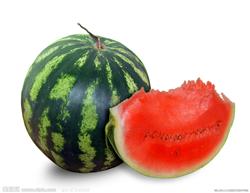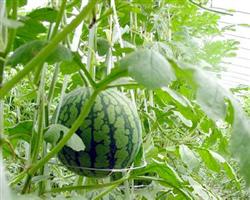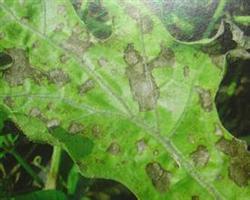Several methods of judging watermelon ripening

1. Accumulated temperature method. Watermelon from flowering to maturity needs a certain accumulated temperature, generally early and mid-maturing varieties from flowering to maturity need 700--800℃, late-maturing varieties need about 1000℃. Therefore, the fruit development days of each variety are basically fixed under the condition of proper sowing time in spring and normal climate. Early maturing varieties need 28- 30 days, such as Jingxin No. 1, medium maturing varieties need 30- 33 days, such as Shubao, late maturing varieties need 35- 40 days, such as Teda Xinhongbao, so it is most reliable for melon farmers to identify fruit maturity by timing. The specific method is: when watermelon blossoms, after each plant is artificially pollinated, it is marked, and the fruit is harvested on time at the maturity stage, so that the maturity degree can be confirmed. However, the fruit setting position of the same variety and the temperature during fruit development have a great relationship with the speed of fruit ripening. If the fruit setting node is high (that is, close to the root) and the temperature during fruit development is high, the flowering and harvesting days should be shortened accordingly; otherwise, it will be prolonged. The daily temperature and sunshine time should also be recorded after pollination, so as to accurately judge the maturity of watermelon. In a large number of harvest at the same time before pollination melon can also taste one or two to test its maturity. 2. Fruit character observation method. Fruit ripeness after the general hard smooth peel with luster, peel pattern clear, showing the inherent variety of ripe melon skin color. Fruit umbilicus (corolla shedding) and fruit pedicle (fruit stalk insertion) parts contract inward, concave, fruit landing part turns yellow rough, fruit stalk bristles sparse yellow is not obvious, that is, ripe melon. In addition, withering of tendrils at the same node or in front of the fruit can also be used as a sign of fruit maturity, but it varies according to the strength of plant growth. For example, in the multi-ripening of watermelon, the stems and leaves of the first and second crops grow vigorously during the harvest period, although the fruits are mature, but the tendrils are not necessarily withered; the stems and leaves of the third crop grow and decline, although the tendrils have withered, the fruits may not be mature. Therefore, it should be judged comprehensively in combination with other conditions. 3. Play melon and listen to sound law. Mature fruits have a smooth feeling by touching the melon surface with hands, and the sound of "bang bang" is emitted by fingers. The sound emitted by immature melons is the solid sound of "bang bang". If the sound is "pu pu", it is over-ripe melon. It should be noted that when there is more rain in the fruiting period, the sound heard after playing melon is solid sound, but melon is ripe. In addition, some varieties with tight skin, after the fruit matures, the sound of "thung" still with fingers should be treated differently. 4. Specific gravity method. Generally, the proportion of mature watermelon is between 0.90 and-0.95. More than this number indicates that it is not yet mature, and less than 0.90 indicates that the melon is overripe. Because watermelon ripens, the empty cells in the cells increase, the middle glue layer of the pulp cells begins to dissociate, the cell gap is filled with air, and the placenta tissue gap at the seed is enlarged, so the specific gravity decreases. With the hand to hold melon feel hair light, with the hand to tap melon surface, palm feel slightly trembling for hot melon. If continuous fruit is required, after topdressing and watering during the fruiting period, sometimes mature fruits will return to life 3- 4 days after topdressing, and this return melon should be extended for 4- 5 days. In order to obtain better economic benefits, ethephon (dichloroethyl phosphate) can be used to ripen when it is necessary to market ahead of time. The method of treatment is that when the fruit is large and not yet mature (i.e. 26--28 days after flowering), 200 mg/kg of ethephon solution is smeared along the melon surface around evening, and a small amount of soap powder can be added to the solution to increase adhesion. After two days, it can be harvested and marketed. Compared with natural ripening fruit, the treated fruit could be supplied to market 3- 5 days earlier, and its quality was not reduced, but improved. For those who cannot accurately judge, they should constantly accumulate experience in production practice, ponder the character performance of common watermelon varieties, combine the temperature and sunshine conditions of the season, comprehensively judge by various means such as "seeing, hearing and holding hands", and constantly increase the "feeling" for judging ripe melons, so as to make perfect practice and master them skillfully.
- Prev

Cultivation techniques of watermelon hanging vine in solar greenhouse
The cultivation season is in the early spring. The seedlings were sowed and raised in the middle and last ten days of February, the seedling age was 35 to 40 days, the seedlings were raised by heating, planted in the greenhouse in the first and middle of April, and listed in early June. The cultivation is postponed in autumn. The seeds were sown in late July and the seedling age was about 20 days. Cover greenhouse film in early September, cover thermal insulation grass curtain in late September, and appear on the market around October. Planted in winter and spring.
- Next

Simple control techniques of watermelon diseases
Before sowing, select the greenhouse that has not planted melon crops, or use the shed with high temperature in summer leisure period, in order to prevent the invasion of soil-borne diseases such as Fusarium wilt, sudden collapse, blight and anthracnose at seedling stage. The seeds were soaked in 55 ℃ warm water for 10 minutes, stirred continuously, cooled and soaked for 6 hours, then.
Related
- Moge, come on! The staff of the peasant association in the producing area of cantaloupe were frightened when the crowd gathered.
- Causes and Solutions of low Fruit setting rate of Apple
- Symptoms and control measures of passion fruit virus disease
- Fruit growing lesson: how do apple orchards keep high yields?
- Can you build orchards in the mountains? What are the pros and cons?
- How to manage the coloring period of Crisson grape?
- This paper introduces the processing technology of two kinds of fig products.
- How much is a month for retired teachers in rural areas by 2020?
- How can strawberry planting increase sugar content? We should pay attention to management in many aspects.
- What are the cultivation techniques on how to improve the yield of golden fruit?

